
Wheat is a grass widely cultivated for its seed, a cereal grain which is a worldwide staple food. The many species of wheat together make up the genus Triticum; the most widely grown is common wheat. The archaeological record suggests that wheat was first cultivated in the regions of the Fertile Crescent around 9600 BCE. Botanically, the wheat kernel is a type of fruit called a caryopsis.
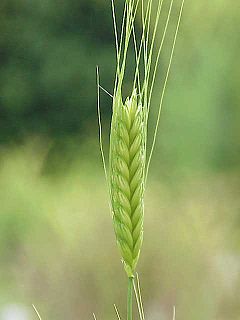
Einkorn wheat can refer either to the wild species of wheat, Triticum boeoticum, or to the domesticated form, Triticum monococcum. The wild and domesticated forms are either considered separate species, as here, or as subspecies: Triticum monococcum subsp. boeoticum (wild) and T. monococcum subsp. monococcum (domesticated). Einkorn is a diploid species of hulled wheat, with tough glumes ('husks') that tightly enclose the grains. The cultivated form is similar to the wild, except that the ear stays intact when ripe and the seeds are larger. The domestic form is known as "petit épeautre" in French, "Einkorn" in German, "einkorn" or "littlespelt" in English, "piccolo farro" in Italian and "escanda menor" in Spanish. The name refers to the fact that each spikelet contains only one grain.

Triticale is a hybrid of wheat (Triticum) and rye (Secale) first bred in laboratories during the late 19th century in Scotland and Germany. Commercially available triticale is almost always a second-generation hybrid, i.e., a cross between two kinds of primary (first-cross) triticales. As a rule, triticale combines the yield potential and grain quality of wheat with the disease and environmental tolerance of rye. Only recently has it been developed into a commercially viable crop. Depending on the cultivar, triticale can more or less resemble either of its parents. It is grown mostly for forage or fodder, although some triticale-based foods can be purchased at health food stores and can be found in some breakfast cereals.
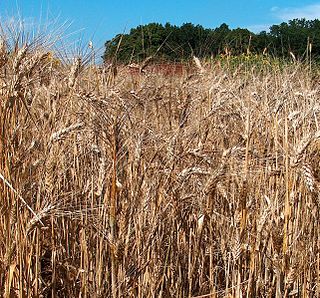
Durum wheat, also called pasta wheat or macaroni wheat, is a tetraploid species of wheat. It is the second most cultivated species of wheat after common wheat, although it represents only 5% to 8% of global wheat production. It was developed by artificial selection of the domesticated emmer wheat strains formerly grown in Central Europe and the Near East around 7000 BC, which developed a naked, free-threshing form. Like emmer, durum wheat is awned. It is the predominant wheat that grows in the Middle East.
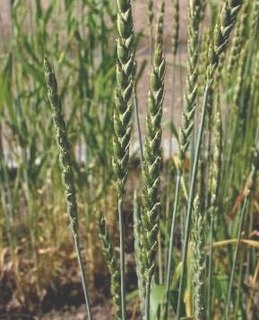
Spelt, also known as dinkel wheat or hulled wheat, is a species of wheat that has been cultivated since approximately 5,000 BC.

Khorasan wheat or Oriental wheat, commercially known as Kamut, is a tetraploid wheat species. The grain is twice the size of modern-day wheat, and has a rich, nutty flavor. Khorasan refers to its origin in the Fertile Crescent region of the Middle East.
The founder crops are the eight plant species that were domesticated by early Neolithic farming communities in southwest Asia, which formed the basis of systematic agriculture in the Middle East, North Africa, India, Persia and Europe. They consist of flax, three cereals and four pulses, and are the first known domesticated plants in the world. Although domesticated rye occurs in the final Epi-Palaeolithic strata at Tell Abu Hureyra, it was insignificant in the Neolithic Period of southwest Asia and only became common with the spread of farming into northern Europe several millennia later.

Common wheat, also known as bread wheat, is a cultivated wheat species. About 95% of wheat produced worldwide is common wheat; it is the most widely grown of all crops and the cereal with the highest monetary yield.
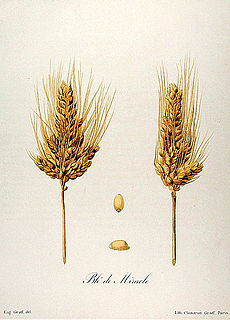
During 10,000 years of cultivation, numerous forms of wheat, many of them hybrids, have developed under a combination of artificial and natural selection. This diversity has led to much confusion in the naming of wheats. This article explains how genetic and morphological characteristics of wheat influence its classification, and gives the most common botanical names of wheat in current use. Information on the cultivation and uses of wheat is at the main wheat page.
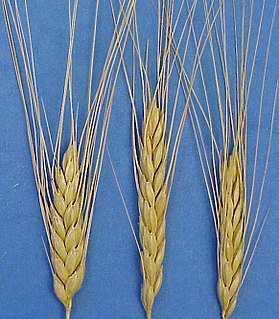
Farro refers to the grains of three wheat species, which is sold dried, and cooked in water until soft. It is eaten plain or is often used as an ingredient in salads, soups, and other dishes.

Triticeae is a botanical tribe within the subfamily Pooideae of grasses that includes genera with many domesticated species. Major crop genera found in this tribe include wheat, barley, and rye; crops in other genera include some for human consumption, and others used for animal feed or rangeland protection. Among the world's cultivated species, this tribe has some of the most complex genetic histories. An example is bread wheat, which contains the genomes of three species with only one being a wheat Triticum species. Seed storage proteins in the Triticeae are implicated in various food allergies and intolerances.
Tapesia yallundae is the causal agent for a variety of cereal and forage grass diseases. The anamorph of T. yallundae is the W-type strain of Pseudocercosporella herpotrichoides. The R-type strain of Pseudocercosporella herpotrichoides is now known as Tapesia acuformis.

Triticum timopheevii, Timopheev's wheat or Zanduri wheat, is a tetraploid wheat that has both cultivated and wild forms. It is believed to have evolved in isolation from the more common Triticum turgidum; hybrids between T. timopheevii and T. turgidum are reportedly sterile with "a considerable amount of chromosomal irregularities in meiosis."
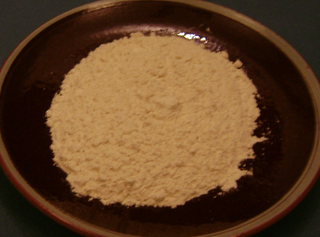
Gluten is the seed storage protein in mature wheat seeds. It is the sticky substance in bread wheat which allows dough to rise and retain its shape during baking. The same, or very similar, proteins are also found in related grasses within the tribe Triticeae. Seed glutens of some non-Triticeae plants have similar properties, but none can perform on a par with those of the Triticeae taxa, particularly the Triticum species. What distinguishes bread wheat from these other grass seeds is the quantity of these proteins and the level of subcomponents, with bread wheat having the highest protein content and a complex mixture of proteins derived from three grass species.
In enzymology, a NDP-glucose—starch glucosyltransferase is an enzyme that catalyzes the chemical reaction

Triticum polonicum, also known as the Polish wheat, is a spring wheat variety of wheat. It is an allotetraploid (AABB) species with 28 chromosomes. It can be found in small areas of the Mediterranean region, Ethiopia, Russia and in other regions of Asia. It was first described by Carl Linnaeus in 1762. T. polonicum is characterised by longer glumes and grains.
Hulled wheat can refer to:
Triticum urartu, also known as red wild einkorn wheat, and a form of einkorn wheat, is a grass species related to wheat, and native to western Asia. It is a diploid species whose genome is the A genome of the allopolyploid hexaploid bread wheat Triticum aestivum, which has genomes AABBDD.

Triticum compactum or club wheat is a species of wheat adapted to low-humidity growing conditions. T. compactum is similar enough to common wheat that it is often considered a subspecies, T. aestivum compactum. It can be distinguished by its more compact ear due to shorter rachis segments, giving it its common name. In the United States of America, nearly all T. compactum is grown in dry areas of the Pacific Northwest.
Ernest "Ernie" Robert Sears was an American geneticist, botanist, pioneer of plant genetics, and leading expert on wheat cytogenetics. Sears and Sir Ralph Riley (1924–1999) are perhaps the two most important founders of chromosome engineering in plant breeding.














